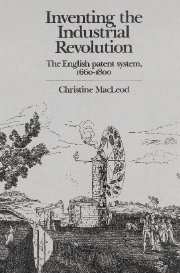Book contents
- Frontmatter
- Contents
- List of tables and figure
- Acknowledgements
- List of abbreviations
- Notes on style
- Introduction
- 1 Patents 1550–1660: law, policy and controversy
- 2 The later-Stuart patent grant – an instrument of policy?
- 3 The development of the patent system, 1660–1800
- 4 The judiciary and the enforcement of patent rights
- 5 The decision to patent
- 6 Invention outside the patent system
- 7 Patents in a capitalist economy
- 8 The long-term rise in patents
- 9 The goals of invention
- 10 Patents: criticisms and alternatives
- 11 A new concept of invention
- Notes
- Bibliography
- Index
5 - The decision to patent
Published online by Cambridge University Press: 28 October 2009
- Frontmatter
- Contents
- List of tables and figure
- Acknowledgements
- List of abbreviations
- Notes on style
- Introduction
- 1 Patents 1550–1660: law, policy and controversy
- 2 The later-Stuart patent grant – an instrument of policy?
- 3 The development of the patent system, 1660–1800
- 4 The judiciary and the enforcement of patent rights
- 5 The decision to patent
- 6 Invention outside the patent system
- 7 Patents in a capitalist economy
- 8 The long-term rise in patents
- 9 The goals of invention
- 10 Patents: criticisms and alternatives
- 11 A new concept of invention
- Notes
- Bibliography
- Index
Summary
It is evident that numerous inventions went unpatented and, conversely, that many patents were taken out for apparently unworkable or trivial devices. For what reason did some inventors decide to patent their inventions, and others not? What were patentees doing when they patented inconsequential, mundane, or technically unfeasible devices? A patent will be shown to have served several functions beyond the straightforward protection of an invention. The system's clients discovered a variety of uses for their expensive pieces of parchment. As a royal grant, a patent conferred prestige on an enterprise; it also afforded a degree of immunity from the regulation of craft guilds and other corporate bodies. With the decline and dissolution of the guilds in the eighteenth century and the concomitant intensification of competition, the former benefit grew at the expense of the latter. This shifted the balance of the system's usage towards established tradesmen and manufacturers. For a few decades at the end of the eighteenth century, prior to the emergence of professional inventors and the attendant ‘invention industry’, the patent system offered more to those inside manufacturing than to those on its periphery. This trend was reinforced by the growth of defensive patenting. To a large extent, the patent system created its own market: as its existence became more widely known, not only were inventors and manufacturers more willing to use it, they also became more fearful of not using it. This chapter concentrates on the elements in the decision confronting the potential patentee at the level of individual motivations.
- Type
- Chapter
- Information
- Inventing the Industrial RevolutionThe English Patent System, 1660–1800, pp. 75 - 96Publisher: Cambridge University PressPrint publication year: 1988



